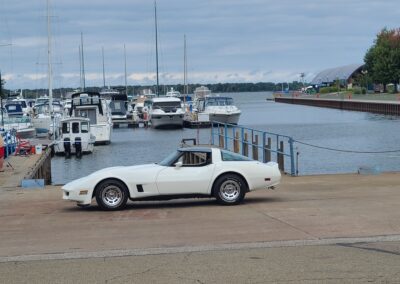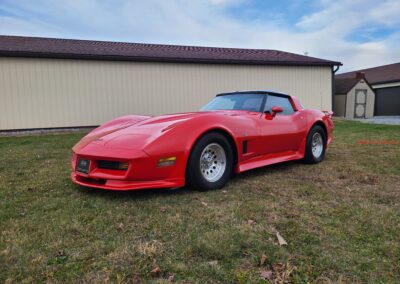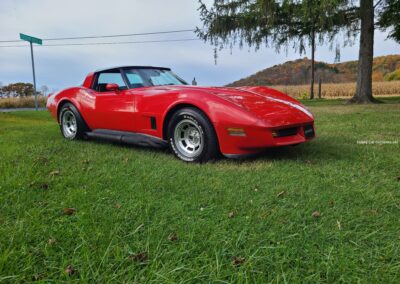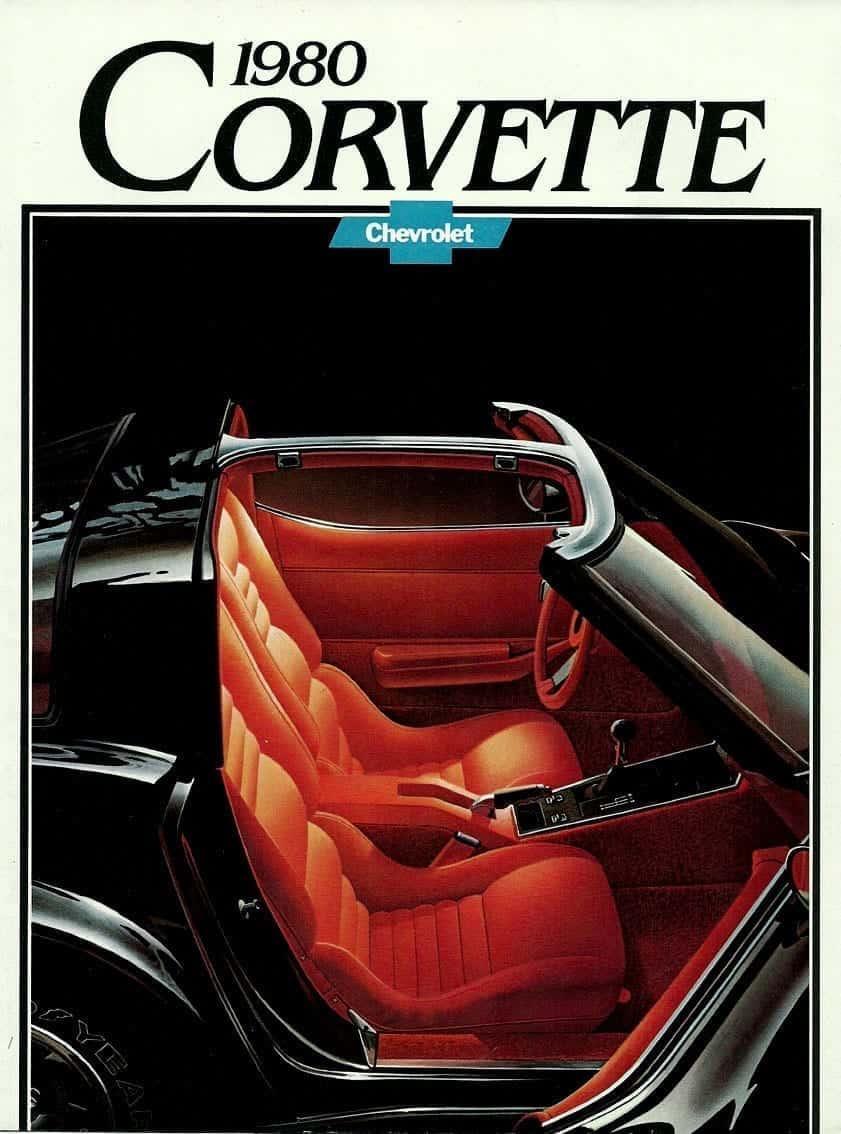1980 CORVETTE
Welcome back to Hobby Car Corvettes as we continue with our exciting C3 Vette series. Each week, we review the next in line of the fifteen impressive machines in the third generation of Corvettes. Last week, we had nothing but praise to offer for the 1979 Corvette, and this week we we will be visiting the 1980 C3 Corvette.
We started this series because here at Hobby Car Corvettes in Martinsburg, PA, we personally feel the third generation of Corvettes was the best! While we are all-around Corvette enthusiasts, the third generation will always be our favorite generation. Wasting no more time, let’s get to it and learn all there is to know about the 1980 Corvette!
OIL CRISIS STRIKES AGAIN
The year of 1980 brought again an oil crisis that would have a direct impact on federal mandates for all vehicle manufacturers. The most impactful mandate, required improvements in fuel efficiency. It was beginning to be realized that fuel was not an ample and renewable supply, and so vehicles had to be smart about their use of the resource. Chevrolet set straight away to modifying the Corvette in the best way possible to meet these new mandates. As always, they did their best to simultaneously improve form and function.
The first goal was to eliminate 250 pounds from the current design, which would increase fuel efficiency. The challenge that Chevrolet engineers and designers were up to was removing the weight while maintaining Corvette’s reputable structure and image.
They began by using lighter materials. The differential housing and front-frame cross-member were switched from steel to aluminum, a much lighter option. In previous years, the L82 engine was fitted with an aluminum intake manifold, and this piece was now included on the L48 engine as well.
The use of chrome was kept to a minimum, and far more plastic was used where it could be. The crossed flags emblem was removed from the front fender. Though it seems a small change, every removal and addition mattered. Additionally, engineers used lower density roof panels and reduced thickness of the hood and outer door skirts.
In addition to reducing weight, engineers worked to improve Corvette gas mileage overall. They did this by making appropriate changes to reduce drag. The front and rear spoilers were reshaped and made an integral part of the bodywork. The front grill was raked back just slightly.
1980 CORVETTE AESTHETICS
In regards to aesthetics, the front and rear spoiler change made for improved fuel efficiency was one of the most notable changes. Additionally, the raked back grill and removal of the front fender emblem affected the overall appearance of the 1980 Corvette. The emblem that would still be found on the Corvette, was redesigned with new elongated flags.
The 1980 Corvette hood had a lower profile with new cornering and taillights. The storage that could be found in the rear was changed from three lids to two. While the battery remained in its own separate compartment behind the driver, the center and passenger side compartments were combined and now accessed with a single door.
A new aesthetic option offered for the interior was a new ribbed cloth.
1980 CORVETTE MECHANICS
It comes as no surprise that the 1980 Corvette suffered somewhat in regards to power and mechanics due to the ever tightening regulations. The base L48 engine lost 5 hp, dropping it from 195 hp to 190 hp at 4,400 rpm and 280lbs/ft of torque at 2,400 rpm. On the flip side, the L82 benefited from the changes, jumping from 225 hp to 230 hp.
Some features that were made standard included power windows, air-conditioning, and tilt-telescopic steering.
Additionally, a new convenience group was created that included time-delayed dome and courtesy light operation, a headlight warning buzzer that signaled when the headlights were left on, a low-fuel warning light, intermittent windshield wipers, and a passenger-side illuminated visor mirror. These are many of the modern conveniences we appreciate today. Though even some of these are a thing of the past as many headlights turn on and off independently.
THE 1980 CORVETTE IN CALIFORNIA
But specific to only one state, was the impact that California emission standards had on the Corvette. GM engineers, unfortunately, were not able to certify the “high-compression” (9:1) small block for California use. Nationwide, the demand for it had already dropped significantly at the end of 1979. Because of this, 1980 would be the last year for the optional L82 engine.
Due to the California’s more stringent regulations, the 1980 Corvette option for California residents had only one engine, a 305 ci. This engine was the same engine used in Chevrolet’s standard passenger car models. However, in an effort to make it Corvette specific, the engine was equipped with stainless-steel tubular exhaust headers, a computer command control system, and an oxygen sensor in a closed loop system.
With these few changes, Chevrolet was was able to improve the 305 ci engine available to California buyers, producing an output of 180 hp. This output was only 10 hp lower than the standard L48 available in all other states. This option for the 305 ci engine, was mandated due to Chevrolet’s inability to certify that the small-block 350 ci engine could meet all of California’s emission requirements.
DID YOU KNOW
-
While California consumers received a $50.00 credit as a result of this downgrade, the LG4 305 ci engine was only available with an automatic transmission, making it even less desirable to true sports-car enthusiasts.
-
As a result of federal mandate, the 1980 Corvette was the first year to have a speedometer with an upper limit of only 85 MPH
-
1980 would be the last year for the optional L82 engine.
-
It was President Jimmy Carter himself who enforced the reduction of MPH on speedometers. It was not a decision well-received.
CONCLUSION
With a hefty increase in the Corvette price tag, and a significant decline in Corvettes sold, it wasn’t the strongest year for the third generation. The number of cars sold dropped 20% from 1979, selling only 40,614 Corvettes. Despite the decline, this is still a large number of cars to be sold, and so it was clear that Corvette enthusiasts were still devoted.
It’s possible that numbers dipped due to price increase. The year began with a price tag of $13,140.24 for a 1980 Corvette and ended at $14,345.24. It’s also possible the dip was in response to feelings of disappointment. With the changes made to increase fuel efficiency, using less chrome and more plastic, some opinions offered that Corvette was losing some of its original feel and standards.
These lukewarm feelings had the conversations growing that it was time to consider a new generation of Corvettes. No matter the reason for the drop in sales, we are nearing the end of the third generation of Corvettes.
As always, thank you for stopping by here at Hobby Car Corvettes, for our series on third generation Corvettes. We hope this specific year added to your well of Corvette knowledge. Please return next week as we head into the final two years of the third generation of Corvettes.
As always, if you are in the market for your very own Corvette, reach out to us here in Martinsburg, PA. We proudly and competently sell nationwide and international. Check out the 1980 Corvettes we have to offer below, and feel free to peruse our large Corvette inventory!
See you next week!
We currently have the following 1980 corvettes for sale:
Just Arrived 350 engine, automatic transmission, 94,441 original miles, A/C, black interior, power steering, power brakes, power windows, tilt and telescopic steering column, dual sport mirrors, AM/FM/CD Just Arrived 350 engine, automatic transmission, 94,441 original miles, A/C, red leather interior, power steering, power brakes, power windows, tilt and telescopic steering column, dual sport mirrors, Just Arrived Don’t miss out on this incredible opportunity to own a rare and stunning 1980 Corvette! With only 37,878 original miles, this beauty boasts a numbers Just Arrived Numbers matching, L48/350 engine, 99,999 miles on dash (title is exempt for mileage), automatic transmission, power steering, power brakes, power windows, red leather interior, tilt Just Arrived Numbers matching, L48/350 engine, automatic transmission, 94,441 original miles, A/C, red leather interior, power steering, power brakes, power windows, tilt and telescopic steering column, dual Just Arrived Numbers matching, L48/350 engine, 84,873 original miles, 4 speed manual transmission, black leather interior, power steering, power brakes, power windows, AM/FM/CD, glass T Tops, tilt Just Arrived Numbers matching, 44,714 original miles, L82/230hp engine, automatic transmission, black custom interior, power steering, power windows, A/C, glass t tops, power brakes, AM/FM radio, aftermarket Just Arrived Numbers matching, L48/350 engine, automatic transmission, 39,020 original miles, glass T-Tops, black leather interior, alloy wheels, AM/FM radio, power steering, power brakes, power windows, sport Just Arrived 350 crate engine, automatic transmission, 63,983 original miles, X-A/C, oyster leather interior, alloy wheels, power steering, power brakes, power windows, AM/FM/Cassette player, sport mirrors, tilt
1980 Burgundy Corvette Black Interior For Sale
Automatic
1980 White Corvette Red Interior Hot Rod For Sale
Automatic
1980 Black Corvette 4spd Oyster Interior For Sale
Manual
L48/350
37,878 original
1980 Silver Corvette Red Interior T Top
Automatic
L48/350
99999 on dash
1980 White Corvette Red Int For Sale
Automatic
L48/350
94,441 on dash
1980 White Corvette Black Interior 4spd For Sale
Manual
L48/350
84,873
1980 Red L82 Corvette Black Interior For Sale
Automatic
L82/350
44,714 Original
1980 Real Red Corvette T Top
Automatic
L48/350
39,020 Original
1980 Red Corvette Oyster Interior T Top For Sale
Automatic
350
63,983 Original
SPECS
| MODEL | 1980 CHEVROLET CORVETTE |
| GENERATION | C3 |
| BODY STYLE | Two-door coupe, front engine, rear wheel drive |
| MANUFACTURING LOCATION | St. Louis, Missouri |
| Original Price | $14,345.24 (Coupe) |
| Units Produced | 40,614 |
| EXTERIOR
COLORS |
White, Silver, Black, Dark Blue, Dark Brown, Yellow, Dark Green, Frost Beige, Dark Claret, Red |
| INTERIOR
COLORS |
Oyster, Black, Dark Blue, Doeskin, Red, Claret |
| CONSTRUCTION | Uniconstruction: fiberglass reinforced plastic (FRP or “fiberglass”) body backboned by a steel cage outlining the the passenger compartment. Principal members – steel front and plastic rear – underbody, front and rear end assemblies, dash panel and hinge pillars are bonded, riveted, and bolted together and to each other. Hood is plastic with bonded plastic reinforcement. Car includes two removable roof panels. Doors are plastic, double paneled, reinforced with steel at hinge and lock locations. Front hinged. |
| VEHICLE NUMBERS (VIN) | 1Z878AS400001 – 1Z878AS440614 (coupe) |
| ENGINE SUFFIX | ZAK: 350 CUBIC INCH, 190 HORSEPOWER, AUTOMATIC TRANSMISSION
ZAM: 350 CUBIC INCH, 190 HORSEPOWER, MANUAL TRANSMISSION ZBC: 350 CUBIC INCH, 230 HORSEPOWER, AUTOMATIC TRANSMISSION ZBD: 350 CUBIC INCH, 230 HORSEPOWER, UNCERTAIN USAGE ZCA: 305 CUBIC INCH, 180 HORSEPOWER, CALIFORNIA EMISSIONS |
| ENGINE BLOCK NUMBER | 14010207: 350 CUBIC INCH, 190 HORSEPOWER, 230 HORSEPOWER, LATE PRODUCTION
3970010: 350 CUBIC INCH, 190 HORSEPOWER, 230 HORSEPOWER 4715111: 305 CUBIC INCH, 180 HORSEPOWER, AUTOMATIC TRANSMISSION, CALIF. EMISSIONS |
| HEAD NUMBER | 462624: 350 CUBIC INCH, 190 HORSEPOWER, 230 HORSEPOWER
14014416: 305 CUBIC INCH, 180 HORSEPOWER |
| CARBURETOR NUMBERS | ROCHESTER Q-jet #17080204: 350 C.I., 190HP, AUTOMATIC TRANSMISSION
ROCHESTER Q-jet #17080207: 350 C.I., 190HP, MANUAL TRANSMISSION ROCHESTER Q-jet #17080228: 350 C.I., 230HP, AUTOMATIC TRANSMISSION ROCHESTER Q-jet #17080504, 17080517: 305 C.I., 180HP, AUTO. TRANS, CALIF. EMISSIONS |
| DISTRIBUTOR NUMBER | 1103287: 350 CUBIC INCH, 190HP,MANUAL TRANSMISSION
1103352: 350 CUBIC INCH, 190HP, AUTOMATIC TRANSMISSION 1103353: 350 CUBIC INCH, 190HP, AUTOMATIC TRANSMISSION 1103368: 305 CUBIC INCH, 180HP, AUTOMATIC TRANSMISSION, CALIFORNIA EMISSIONS 1103435: 350 CUBIC INCH, 230 HP, AUTOMATIC TRANSMISSION |
| ALTERNATOR NUMBER | 1101041, 1101075, 1101085, 1101088, 1103122 |
| AXLE IDENTIFICATION NUMBER | OF: 3.07:1 RATIO
OH: 3.07:1 RATIO |
| PRODUCTION ENDING VEHICLE | SEP., 1979: 400011, OCT., 1979:404267, NOV., 1979: 408343, DEC., 1979: 411652, JAN., 1980: 416198, FEB., 1980: 420057, MAR., 1980: 424380, APR., 1980: 427800, MAY., 1980: 431152, JUNE, 1980: 434509, JULY, 1980: 438049, AUG., 1980: 440614 |
Options Codes, Production, & Pricing
| CODES | DESCRIPTION | QUANTITY | RETAIL PRICE |
| 1YZ87 | Base Corvette Sport Coupe | 40,614 | $13,140.24 |
| AU3 | Power Door Locks | 32,692 | $140.00 |
| CC1 | Removable Glass Roof Panels | 19,695 | $391.00 |
| C49 | Rear Window Defogger | 36,589 | $109.00 |
| FE7 | Gymkhana Suspension | 9,907 | $55.00 |
| F51 | Heavy Duty Shock Absorbers | 1,695 | $35.00 |
| K30 | Cruise Control | 30,821 | $123.00 |
| LG4 | 305ci, 180hp Engine (required in CA) | 3,221 | $50.00 |
| L82 | 350ci, 230hp Engine | 5,069 | $595.00 |
| MM4 | 4-Speed Manual Transmission | 5,726 | $0.00 |
| MX1 | Automatic Transmission | 34,838 | $0.00 |
| N90 | Aluminum Wheels (4) | 34,128 | $407.00 |
| QGB | White Letter SBR Tires, P225/70R15 | 26,208 | $62.00 |
| QXH | White Letter SBR Tires, P255/60R15 | 13,140 | $426.16 |
| UA1 | Heavy Duty Battery | 1.337 | $22.00 |
| UM2 | AM-FM Radio, stereo with 8-track tape | 6,138 | $46.00 |
| UN3 | AM-FM Radio, stereo with cassette | 15,708 | $155.00 |
| UP6 | AM-FM Radio, stereo with CB | 15,148 | $168.00 |
| U58 | AM-FM Radio, stereo | 2,434 | $391.00 |
| U75 | Power Antenna | 32,863 | $56.00 |
| UL5 | Radio Delete | 201 | $126.00 |
| U81 | Dual Rear Speakers | 36,650 | $52.00 |
| V54 | Roof Panel Carrier | 3,755 | $125.00 |
| YF5 | California Emission Certification | 3,221 | $250.00 |
| ZN1 | Trailer Package | 796 | $105.00 |
TRANSMISSION CODES
| CODE | TRANSMISSION |
| ZJ | Warner 4-Speed, Heavy-Duty Aluminum Case, Wide-Ratio (2.88:1 1st Gear) |
| JC | Turbo Hydra-Matic 350 with 305 California Engine |
| TW | Turbo Hydra-Matic 350 with 350 Engine |












